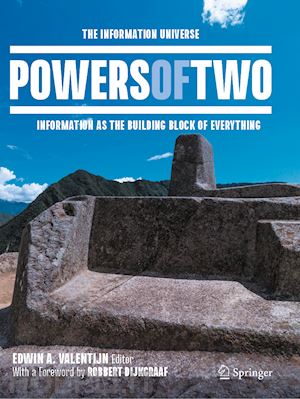
Questo prodotto usufruisce delle SPEDIZIONI GRATIS
selezionando l'opzione Corriere Veloce in fase di ordine.
Pagabile anche con Carta della cultura giovani e del merito, 18App Bonus Cultura e Carta del Docente
Is everything Information? This is a tantalizing question which emerges in modern physics, life sciences, astronomy and in today’s information and technology-driven society. In Powers of Two expert authors undertake a unique expedition - in words and images - throughout the world (and scales) of information. The story resembles, in a way, the classic Powers of Ten journeys through space: from us to the macro and the micro worlds . However, by following Powers of Two through the world of information, a completely different and timely paradigm unfolds. Every power of two, 1, 2, 4, 8…. tells us a different story: starting from the creation of the very first bit at the Big Bang and the evolution of life, through 50 years of computational science, and finally into deep space, describing the information in black holes and even in the entire universe and beyond…. All this to address one question: Is our universe made of information? In this book, we experience the Information Universe in nature and in our society and how information lies at the very foundation of our understanding of the Universe.
From the Foreword by Robbert Dijkgraaf:
This book is in many ways a vastly extended version of Shannon’s one-page blueprint. It carries us all the way to the total information content of the Universe. And it bears testimony of how widespread the use of data has become in all aspects of life. Information is the connective tissue of the modern sciences. […] Undoubtedly, future generations will look back at this time, so much enthralled by Big Data and quantum computers, as beholden to the information metaphor. But that is exactly the value of this book. With its crisp descriptions and evocative illustrations, it brings the reader into the here and now, at the very frontier of scientific research, including the excitement and promise of all the outstanding questions and future discoveries.
Message for the e-reader of the book Powers of Two
The book has been designed to be read in two-page spreads in full screen mode.
For optimal reader experience in a downloaded .pdf file we strongly recommend you use the following settings in Adobe Acrobat Reader:
- Taskbar: View > Page Display > two page view
- Taskbar: View > Page Display > Show Cover Page in Two Page View
- Taskbar: ^ Preferences > Full Screen > deselect " Fill screen with one page at a time"
- Taskbar: View > Full screen mode or ctrl L (cmd L on a Mac)
*****
Note: for reading the previews on Spinger link (and on-line reading in a browser), the full screen two-page view only works with these browsers:
Firefox
- Taskbar: on top of the text, at the uppermost right you will see then >> (which is a drop-down menu) >> even double pages
- Fullscreen: F11 or Control+Cmd+F with Mac
Edge
- Taskbar middle: Two-page view and select show cover page separately
Prof. Dr. Edwin A. Valentijn (1952) is professor of Astronomical Information Technology at the Kapteyn Astronomical Institute, University of Groningen, the Netherlands. His research focusses on dark matter and Big Data information systems handling astronomical imaging surveys. In 2002 he founded, and he still leads, the astronomical data centre OmegaCEN; since 2008 he has coordinated the Target initiative to port astronomical technologies to other disciplines. Valentijn founded the Target Holding company and the NL data center for the Euclid satellite. Currently, he leads the Target Field Lab with research programmes on Virtual reality and Facts and Fakes recognition. Valentijn initiated and is creative director of a digital planetarium, DOTliveplanetarium, in Groningen.











Il sito utilizza cookie ed altri strumenti di tracciamento che raccolgono informazioni dal dispositivo dell’utente. Oltre ai cookie tecnici ed analitici aggregati, strettamente necessari per il funzionamento di questo sito web, previo consenso dell’utente possono essere installati cookie di profilazione e marketing e cookie dei social media. Cliccando su “Accetto tutti i cookie” saranno attivate tutte le categorie di cookie. Per accettare solo deterninate categorie di cookie, cliccare invece su “Impostazioni cookie”. Chiudendo il banner o continuando a navigare saranno installati solo cookie tecnici. Per maggiori dettagli, consultare la Cookie Policy.